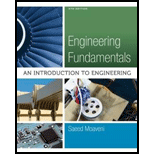
Divide the example problem 8.3 in chapter 8 using the 4.2 section described in textbook into the format “Given” ,“Find” , and “Solution”.
Answer to Problem 25P
The example problem 8.3 in chapter 8 is divided using the 4.2 section described in textbook into the format “Given” ,“Find” , and “Solution”, and the total distance travelled by the car is
Explanation of Solution
Given:
Car accelerates at speed of
The car moves with constant speed of
The car decelerates to a full stop in 10 seconds.
Find:
Find the total distance travelled by the car and also find its average speed over this distance.
Solution:
The car speed is linearly increased from zero to
Therefore, the average speed of the car is
Formula to determine the distance travelled during this period
For the next 30 minutes (1800 s), the car travels with a constant speed of
Formula to determine the distance travelled during this period
For the last 10 sec, the car decelerates at a constant speed of
Therefore, the average speed of the car during the last 10 sec is also
Formula to determine the distance travelled during this period
Formula to determine the total distance covered by the car is,
Convert the unit of total distance from m to km
Formula to determine the average speed of the car for the entire duration of the travel is,
Convert the unit of average speed from
Conclusion:
Hence, the example problem 8.3 in chapter 8 is divided using the 4.2 section described in textbook into the format “Given” ,“Find” , and “Solution”,
Want to see more full solutions like this?
Chapter 4 Solutions
Engineering Fundamentals: An Introduction to Engineering (MindTap Course List)
- find SFD and BMDarrow_forwardThe data needed to answer this question is given by this link: https://docs.google.com/spreadsheets/d/1vzb03U7Uvzm7X-by3OchQNwYeREzbP6Z-xzZMP2tzNw/edit?usp=sharing if it is easier to make a copy of the data because it is on view only then feel free to do so.arrow_forwardThe data needed to answer this question is given in the following link (file is on view only so if you would like to make a copy to make it easier for yourself feel free to do so) https://docs.google.com/spreadsheets/d/1aV5rsxdNjHnkeTkm5VqHzBXZgW-Ptbs3vqwk0SYiQPo/edit?usp=sharingarrow_forward
- The benchmark is 00.00. The backsights are 6.00, 9.32 and 13.75 and 14.00 The foresights are 6.00, 9.00 and 3.22. What is the height of the instrument? H.I. - 100.00 - 124.85 - 43.07- 24.85arrow_forwardThe benchmark is 100.00. The backsights are 4.00, 6.32 and 12.75. The foresights are 6.00, 9.00 and 3.22. What is the elevation of the point? - 95.14 - 123.08 - 104.85 - 81.78arrow_forwardDetermine the stiffness matirx of the entire truss in Global co-ordinate system, clearly indicate the degrees of freedom numbers in the stiffness matrix.arrow_forward
- Determine the stiffness matrices of elements 2, 3 and 4 in the global co-ordinate system. Assume A=0.0015m2 and E=200GPa, indicate the degrees of freedom in all stiffness matricies.arrow_forwardA short plain concrete column with cross-section dimensions of 12 in x 12 in is to be constructed. If the compressive strength of the concrete (f’c) is 5000 psi, what is the maximum load that can be safely applied to the column? - 600 k - 950 k - 720 k - 347 karrow_forwardThe borrow pit has 2000 cyds of suitable fill. The fill required for the project is 1900 cyds. The swell factor is 10% and the shrinkage factor is 15%. How much more borrow do we need? Or is there extra? - 13 yards extra - 13 yards short - 200 yards extra - 161 yards shortarrow_forward
 Engineering Fundamentals: An Introduction to Engi...Civil EngineeringISBN:9781305084766Author:Saeed MoaveniPublisher:Cengage Learning
Engineering Fundamentals: An Introduction to Engi...Civil EngineeringISBN:9781305084766Author:Saeed MoaveniPublisher:Cengage Learning Residential Construction Academy: House Wiring (M...Civil EngineeringISBN:9781285852225Author:Gregory W FletcherPublisher:Cengage Learning
Residential Construction Academy: House Wiring (M...Civil EngineeringISBN:9781285852225Author:Gregory W FletcherPublisher:Cengage Learning

